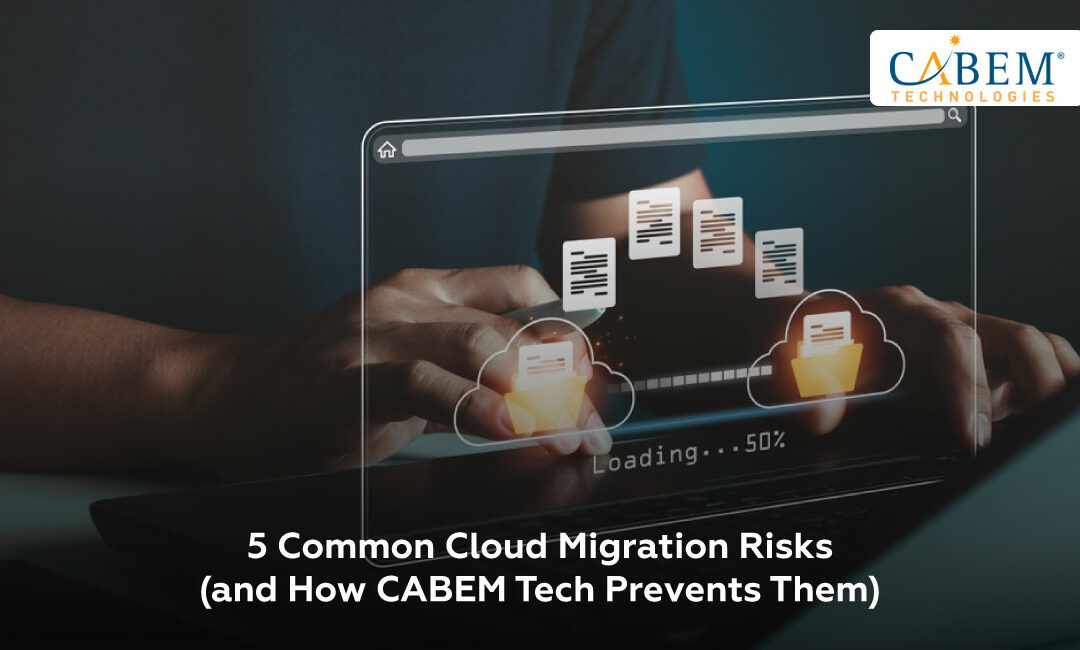Insights and Tools for a Proactive Approach
Cloud migration is the strategic solution for those organizations that want flexibility and operational efficiency. There are many benefits of switching to a cloud-based system, as it is scalable and accessible from anywhere at any time. This strategic move carries risks that can impact the organization’s success if not adequately addressed. It encompasses data breaches to performance issues, and these risks can be potentially costly.
Organizations often overlook the risks associated with cloud migration. Without a proper strategy, they may face challenges such as downtime, security vulnerabilities, and regulatory issues. The proactive approach is crucial for a smooth and secure migration. Otherwise, it can affect productivity and long-term ROI.
In this blog, we will discuss the five most common cloud migration risks and demonstrate how CABEM Tech is a trusted solution provider to mitigate these risks. This article will help you if you are planning to move to a cloud system or are already using one, providing you with the right insights and tools needed to minimize the risks. Let’s start by exploring the risks one by one.
The Five Most Common Cloud Migration Risks
Risk 1: Data Security and Privacy Risks
Data security is one of the primary concerns when transitioning to a cloud-based system. Taking the right precautions is necessary to protect data from cyber threats, breaches, or unauthorized access. Ignoring these concerns may lead to a loss of trust.
- Unencrypted Data in Transit: Encryption is important to ensure data security, unencrypted data may be intercepted by malicious actors during transfer.
- Misconfigured Access Controls: Proper access management is crucial to ensure that only authorized individuals can view or modify the data.
- Loss of Data Integrity: Verifying data integrity through audits is important, as it may become corrupted during migration.
Risk 2: Downtime and Service Interruptions
The second risk that often arises during the data transfer is downtime. Downtime during migration can significantly impact business operations and negatively affect customer experience. Proactive planning is crucial before transitioning to a cloud system.
- Unplanned System Outages: If the downtime is unknown and occurs suddenly during operations, unexpected outages may occur, drastically affecting operations.
- Poor Change Management: Effective change management planning is essential to prevent confusion and technical issues that can arise from an unstructured process.
- Insufficient Testing: Improper testing can cause compatibility issues that may go undetected. Pre-migration testing ensures the application system works perfectly after the move.
Risk 3: Hidden Costs and Budget Overruns
The cloud migration may become expensive if the hidden costs are not accounted for upfront. The organizations may face unexpected financial challenges that drain their budget after the data migration.
- Unexpected Storage and Licensing Fees: It is essential to review current usage and future needs, as many cloud platforms charge based on usage, which can become costly if the data volume is high.
- Third-Party Tool Costs: Identify all necessary tools in the early stage, as additional integration after cloud migration may impact your cloud budget.
- Downtime Recovery Expenses: The recovery of lost productivity due to downtime may add extra cost to your cloud budget. Testing the recovery process minimizes the financial risks associated with downtime.
Risk 4: Lack of Compliance and Governance
The migration of regulated industries to the cloud can expose them to regulatory violations and substantial legal penalties if not done with a proper compliance strategy. Ignoring the governance framework can cause severe consequences.
- HIPAA Violations: The data of the healthcare industry must be handled with security and privacy to prevent access of unauthorized access. Noncompliance with this standard may result in penalties under HIPAA.
- NIST 800-171/CMMC Gaps: Organizations handling government data must meet specific cybersecurity requirements. Not following frameworks like NIST 800-171 or CMMC can lead to a compromise of federal contracts.
- GDPR and Privacy Concerns: The businesses that hold the data of EU citizens must comply with GDPR mandates; failing to follow these standards can trigger legal action.
Risk 5: Poor Application Performance Post-Migration
There are some issues that may arise even after a successful cloud migration if the data infrastructure is not properly planned. The system’s slow performance can irritate users and impact workflow.
- Latency and Slow Response Times: Slow response times can affect operational efficiency and user satisfaction.
- Overloaded Resources: Improper provisioning of resources can overwhelm the cloud environment, leading to application crashes and low performance.
- Incompatibility with Legacy Systems: The legacy software may not work properly with the latest cloud platforms without reengineering. These systems can cause data silos or complete functionality loss.

5 Ways CABEM Tech Prevents These Risks
CABEM Tech’s proactive approach to cloud migration helps organizations avoid risks associated with data transfer. CABEM built smart solutions to ensure secure data transfer with complete reliability and compliance with standards.
- Security by Design: CABEM designs efficient security protocols that work smartly at every layer of the cloud architecture, ensuring secure access control and continuous monitoring.
- Downtime Mitigation: CABEM minimizes the risk of business disruption during the data transfer with detailed migration planning and real-time testing before data transfer begins.
- Transparent Budgeting: CABEM does not impose hidden costs, we provide clear, upfront estimates and cost tracking to keep the budget on track.
- Compliance Built-In: The built-in feature of this platform supports regulatory frameworks like HIPAA, NIST, and GDPR, with automated trails and a policy enforcement mechanism.
- Performance Optimization: CABEM aligns cloud configurations and workloads with organizational needs, thereby enhancing response times and improving overall performance.
Why Choose CABEM Tech for Your Cloud Migration
Choosing the right partner for your cloud migration project is as important as migration itself. CABEM Tech offers security-first migration solutions that are fully adaptable to your organization’s goals and meet the compliance requirements of all regulatory bodies. CABEM has experience working with diverse industries, including healthcare, manufacturing, and government, and possesses technical expertise that provides smart strategies to minimize the risks associated with cloud migration.
Ready to make your cloud migration smooth and stress-free? CABEM Tech supports you at all stages of data migration, from planning to implementation. Our data migration solutions are specifically designed to meet your organizational needs, providing a with a secure data architecture and full visibility and control at all levels. Contact us now and see how CABEM Tech helps you migrate smarter, safer, and faster.
FAQs
- What is privacy vs security risk?
Privacy risk is related to unauthorized access of personal data, while security risk is the potential threat to the system that protects the data.
- Are these risks common to every business, or just certain industries?
These risks can affect any business; however, industries that handle sensitive data are more likely to be impacted by these threats, such as healthcare, finance, and government.
- Can CABEM Tech tailor solutions to meet my unique needs?
Yes. CABEM Tech offers fully customizable solutions tailored to meet the specific needs of each organization, thereby enhancing performance and operational efficiency.
- Can I schedule a demo or consultation with CABEM Tech before committing?
Absolutely. CABEM Tech offers a free consultation to organizations planning to move to a cloud-based system, providing personalized solutions tailored to meet their specific needs.

